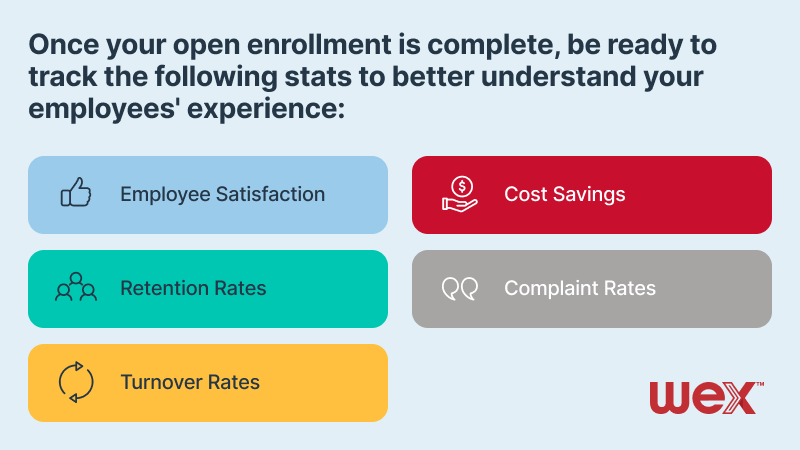Stay connected
Subscribe to our health benefits blog and follow us on social media to receive all our health benefits industry insights.

Open enrollment performance tracking is important to make sure you have a successful period, ensuring you’re offering your employees the best possible benefits packages, and creating a better system for years to come. In the latest blog post in this year’s open enrollment series, we’ve compiled some open enrollment metrics to track.
Communication engagement can provide insights into employee satisfaction and level of engagement. If an open enrollment period sees a decrease in communication engagement, this could be a sign that employees are feeling disinterested or overwhelmed in their benefits offerings.
Engagement tracking can help you understand which methods of communication are more effective, identify areas of improvement, and ensure that employees are properly informed about their benefits.
Different communication engagement areas to track:
Participation rates, incomplete enrollments, or the trends in timing of people’s participation in the open enrollment are all important to track as you evaluate the success of your open enrollment.
Tracking these rates can help identify discrepancies in the process, such as inconsistencies for different groups of individuals. The information gathered can help make improvements to the process in future years.
Tracking incomplete enrollment rates can show where in the process they are struggling, or what communication channels are not effective. Noticing that certain groups are not completing the enrollment process can show where you need to provide more support and education to ensure they understand the benefits options.
Tracking the timing when people participate in open enrollment can also be helpful. This is because you are able to see if the employees are making informed decisions and that the company is meeting the needs of its workforce. Also, this helps monitor the effectiveness of the overall open enrollment process. For example, if the rate of participation is low or employees tend to sign up for benefits at the last minute, the employer may need to adjust the process to make it easier for employees to participate.
Would you like to learn more about the results of our participant survey and how to set yourself up for a successful open enrollment based on their feedback? Get our guide here!
In-person activities are an important metric to track in open enrollment because they provide an understanding of how much personal engagement is occurring in the enrollment process.
This could be tracking the participants in:
Tracking the questions and discussions in these activities can provide an understanding that other metrics cannot provide. Finally, tracking these metrics can give you an understanding of which employees are engaging with the process and which employees may need additional assistance.
Q&A events give employees the opportunity to ask questions about their benefits and receive answers from knowledgeable professionals. By tracking these events, you can identify any areas of confusion and address them proactively. This can help employers identify which benefits are most important to employees and make sure they are providing better ideas of what employees are looking for in their benefits and how they can improve the open enrollment process. This feedback can be used to inform future open enrollment efforts and ensure that employee needs are being met.
One of the most important metrics to track in open enrollment season is post-enrollment. Tracking everything after open enrollment is closed can give insight to the overall performance of the program.

These metrics give valuable information on the effectiveness of the programs outreach and marketing efforts. For example, measuring employee satisfaction and retention rates can show the success of the program in terms of providing the necessary resources and support to those who have enrolled. Tracking retention rates is one indication of customer satisfaction.
Cost savings measures the amount of money saved by the organization through open enrollment. This can help organizations understand how much money they are saving by providing employees with better benefits packages.
The information in this blog post is for educational purposes only. It is not legal or tax advice. For legal or tax advice, you should consult your own legal counsel, tax and investment advisers.
WEX receives compensation from some of the merchants identified in its blog posts. By linking to these products, WEX is not endorsing these products.
Subscribe to our health benefits blog and follow us on social media to receive all our health benefits industry insights.